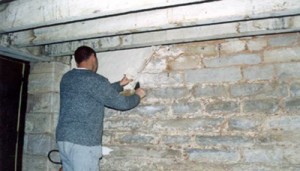Elizabeth Farm
History
Elizabeth Farm 1794: Australia’s oldest European style building, where previous unrestrained salt contamination had caused substantial fabric loss and structural deterioration. Elizabeth Farm was the home of John and Elizabeth Macarthur and was operational from 1793.
This early Australian homestead became the design for many houses that were built after it, because of the wide verandah’s that are particularly suited to hot climate countries. Elizabeth Farm is also considered the birthplace of the Australian wool industry.
The original house was built with bricks, rendered and marked with Ashlar blocking. The servant's quarters and kitchen were built from Sydney sandstone. The sandstone walls were suffering from decay due to high salt contamination caused by rising damp and in some cases previous lateral water problems. Several attempts had been made over the years to try to arrest the problem with limited success. Sacrificial renders have been on the building for some years and have been helpful in holding back the rate of decay, as has the use of traditional type lime washes, particularly in the basement area.
Cocoon
The “Westox Cocoon” material was used on several of the bad walls after the removal of the sacrificial render or lime wash, with the aim of reducing the salts to a “safe” level so sacrificial renders or traditional lime wash could be used with some longevity. The Cocoon was applied in two applications, each application being left for two weeks before removal. Analysis was carried out to verify the transfer of salt from the wall to the Cocoon. The first set of samples were taken prior to application with the second set of samples taken two weeks after the first application. These samples also included a sample of the Cocoon material, taken from over the drill site of the previous samples. A third set of samples was taken after the removal of the second application, which also included a sample of the Cocoon from over the drill site.
Analysis
The analysis of the samples was carried out by the CSIRO and included the types of salts present and the percentage of each type. It is important to know the types of salt present, as this can vary the application procedure of the Cocoon. Experience has shown if a high nitrate contamination is present, then the length of time between Cocoon application and removal changes.
Nitrates, being very mobile, tend to migrate quickly into the Cocoon, if the material is left in place; other salts migrate into the Cocoon and the nitrates, being a deliquescent salt, convert to liquid and soak back into the wall taking the other salt with them. In Australian conditions, we have found that removal of the Cocoon after approximately four days removes a high percentage of the nitrates. The Cocoon is then applied in the two applications, each being for two weeks to reduce the remaining salt contamination. On the other hand, high sulphate contamination tends to be more difficult to remove and three applications are sometimes necessary. If chlorides are present with the sulphates, the migration tends to be completed in the two applications. We believe that the chlorides tend to be more soluble in water and assist to solubilize the sulphates; temperature also has a bearing on the solubility of the sulphates.
The areas that were treated at Elizabeth Farm included a wall in the basement, which was below the external ground level, this wall was lime washed along with the other basement walls after the desalination work, the outside wall of the servants quarters, which was also lime washed after desalination and the internal and external of the laundry walls, which had two types of sacrificial renders applied after the desalination work, with a lime wash being applied over the sacrificial render. All of the existing sacrificial render was removed prior to the application of the Cocoon so that the original stone surface was exposed for the desalination work. In the areas that were originally lime washed, the stone was mostly exposed by the on going exfoliation caused by the salt contamination.
Removal of the second Westox Cocoon application in the basement is seen in the photo below. The area of deterioration is clearly visible.

Results
The results from the applications at Elizabeth Farm showed a significant reduction in most areas, however there were two particular drill sites where it was difficult to obtain good samples for analysis. On one drill hole, the material was very wet and stuck to the drill making it impossible to take uncontaminated samples for each depth. The other drill hole had a hollow area behind the 20mm depth, so the complete set of samples could not be taken.
Precise sampling and analysis is essential if verification of the salt transfer is required. Recording any difficulties experienced while collecting samples should be included in the report, as it will most certainly show in the analysis results. Two different mixes were used for the sacrificial render in an effort to establish if there was any benefit or additional longevity from either mix. Although both mixes followed the traditional 3 parts sand to 1 part slaked lime sacrificial renders, in an effort to provide more long term protection and reduce maintenance requirements, one mix was used at the ratio of 12 parts sand to 4 parts slaked lime to 1 part Portland cement, whilst the other was 3 parts sand to 1 part slaked lime, to which trass flour was added at the ratio of 25% to the lime component by volume.
The areas where the different mixes were used were documented as well as being marked on the renders. These areas included both one internal and one external wall of the laundry area that were badly effected by rising damp, the basement walls that were below the external ground level and the outside wall of the servant's quarters. On the areas that were just lime washed over the desalinated stonework, no render was used.
The work was completed in November 2002 and there is no sign of further deterioration at this time. This is a very positive indication that the salt reduction is at a reasonably “safe” level. As mentioned before, a sacrificial render or a traditional lime wash would start to breakdown within a very short period of time and if enough residual salts were present on the surface of the treated stone, then the deterioration would certainly have been active well before now.
Because Elizabeth Farm was comparatively high in salt contamination, especially nitrates, it should prove as a good indicator for other properties where deterioration from salt contamination needs to be controlled by doing the minimum amount of work. The traditional lime wash used over the desalinated areas should, by there sacrificial nature, provide early warnings of when the salt levels have again reached a stage where there is enough contamination to cause further deterioration. In theory, if it took 210 years for the salt contamination to reach the stage it was at, if all the salt was removed, it should take another 210 years to reach the same level. Of course it would not be allowed to reach the same level when preventing further deterioration, it is as simple as two more applications of cocoon as and when any areas of exfoliation become visible.
An inspection of the areas of desalination carried out in the November 2002 work was made in February 2010 and the results are quite impressive. Only one small area of salt contamination is visible in the laundry area where the sacrificial render was used and another on the outside wall of the servant’s quarters where the lime wash was used. All other areas, including the basement, had no visible signs of salt action. Even the flag stones on the verandahs, which were deteriorating at a very fast rate, have no signs of exfoliation after the cocoon treatment. The former curator of Elizabeth farm, Mr. Gary Crocket confirmed that the maintenance costs associated with lime washing and sacrificial renders had been reduced dramatically.

